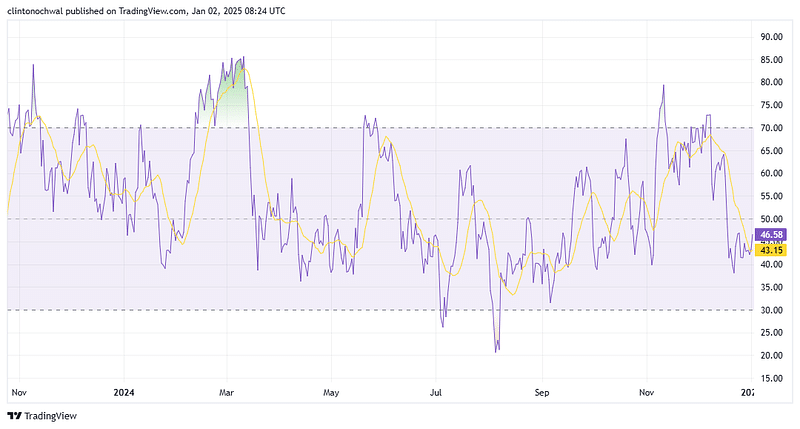| COINOTAG recommends • Exchange signup |
| 💹 Trade with pro tools |
| Fast execution, robust charts, clean risk controls. |
| 👉 Open account → |
| COINOTAG recommends • Exchange signup |
| 🚀 Smooth orders, clear control |
| Advanced order types and market depth in one view. |
| 👉 Create account → |
| COINOTAG recommends • Exchange signup |
| 📈 Clarity in volatile markets |
| Plan entries & exits, manage positions with discipline. |
| 👉 Sign up → |
| COINOTAG recommends • Exchange signup |
| ⚡ Speed, depth, reliability |
| Execute confidently when timing matters. |
| 👉 Open account → |
| COINOTAG recommends • Exchange signup |
| 🧭 A focused workflow for traders |
| Alerts, watchlists, and a repeatable process. |
| 👉 Get started → |
| COINOTAG recommends • Exchange signup |
| ✅ Data‑driven decisions |
| Focus on process—not noise. |
| 👉 Sign up → |
-
Ethereum ETFs have witnessed a substantial uptick in interest, attracting $2.6 billion in inflows during December 2024, signaling growing institutional engagement in the crypto market.
-
Despite the overwhelming dominance of Bitcoin ETFs, which reported $35 billion in inflows last year, Ethereum ETFs are carving out a niche with impressive trading activities.
-
“The shift in investor focus towards Ethereum is palpable,” stated a COINOTAG analyst, reinforcing the asset’s potential in an evolving market landscape.
Ethereum ETFs are on the rise, attracting $2.6 billion in December inflows, as institutional interest and trading volumes surge, raising questions about future performance.
Can Ethereum ETFs outperform Bitcoin ETFs in 2025?
Amidst a backdrop of fluctuating market dynamics, recent analyses indicate that Ethereum ETFs have a legitimate shot at surpassing their Bitcoin counterparts in 2025. This speculation is largely fueled by Ethereum’s laborious staking features, which allow investors to earn rewards proportionate to their holdings, thus enhancing overall yield.
Furthermore, with supportive regulatory changes surfacing, Ethereum ETFs hold potential to attract a wider audience of institutional investors, diversifying market participation.
Notably, during November and December, Ethereum enjoyed a series of eight consecutive weeks of inflows, culminating in a record influx of $2.2 billion in late November. This growing investor confidence highlights Ethereum’s attractiveness as a long-term investment option.
| COINOTAG recommends • Professional traders group |
| 💎 Join a professional trading community |
| Work with senior traders, research‑backed setups, and risk‑first frameworks. |
| 👉 Join the group → |
| COINOTAG recommends • Professional traders group |
| 📊 Transparent performance, real process |
| Spot strategies with documented months of triple‑digit runs during strong trends; futures plans use defined R:R and sizing. |
| 👉 Get access → |
| COINOTAG recommends • Professional traders group |
| 🧭 Research → Plan → Execute |
| Daily levels, watchlists, and post‑trade reviews to build consistency. |
| 👉 Join now → |
| COINOTAG recommends • Professional traders group |
| 🛡️ Risk comes first |
| Sizing methods, invalidation rules, and R‑multiples baked into every plan. |
| 👉 Start today → |
| COINOTAG recommends • Professional traders group |
| 🧠 Learn the “why” behind each trade |
| Live breakdowns, playbooks, and framework‑first education. |
| 👉 Join the group → |
| COINOTAG recommends • Professional traders group |
| 🚀 Insider • APEX • INNER CIRCLE |
| Choose the depth you need—tools, coaching, and member rooms. |
| 👉 Explore tiers → |
As Bitcoin ETFs maintain their stronghold, the accelerating interest in Ethereum ETFs underscores a shifting preference in institutional investment strategies.

| COINOTAG recommends • Exchange signup |
| 📈 Clear interface, precise orders |
| Sharp entries & exits with actionable alerts. |
| 👉 Create free account → |
| COINOTAG recommends • Exchange signup |
| 🧠 Smarter tools. Better decisions. |
| Depth analytics and risk features in one view. |
| 👉 Sign up → |
| COINOTAG recommends • Exchange signup |
| 🎯 Take control of entries & exits |
| Set alerts, define stops, execute consistently. |
| 👉 Open account → |
| COINOTAG recommends • Exchange signup |
| 🛠️ From idea to execution |
| Turn setups into plans with practical order types. |
| 👉 Join now → |
| COINOTAG recommends • Exchange signup |
| 📋 Trade your plan |
| Watchlists and routing that support focus. |
| 👉 Get started → |
| COINOTAG recommends • Exchange signup |
| 📊 Precision without the noise |
| Data‑first workflows for active traders. |
| 👉 Sign up → |
According to market projections, if Ethereum continues to experience upward momentum alongside technological advancements, its ETFs could become frontrunners among crypto asset classes by 2025. Moreover, the integration of artificial intelligence into its infrastructure may further enhance its investment appeal, introducing innovative solutions to traditional challenges.
Key challenges for Ethereum’s market ascent
While the enthusiasm surrounding Ethereum ETFs is palpable, several hurdles remain for them to effectively compete with Bitcoin ETFs. The extensive brand recognition and first-mover advantage enjoyed by Bitcoin pose significant challenges for Ethereum.
| COINOTAG recommends • Traders club |
| ⚡ Futures with discipline |
| Defined R:R, pre‑set invalidation, execution checklists. |
| 👉 Join the club → |
| COINOTAG recommends • Traders club |
| 🎯 Spot strategies that compound |
| Momentum & accumulation frameworks managed with clear risk. |
| 👉 Get access → |
| COINOTAG recommends • Traders club |
| 🏛️ APEX tier for serious traders |
| Deep dives, analyst Q&A, and accountability sprints. |
| 👉 Explore APEX → |
| COINOTAG recommends • Traders club |
| 📈 Real‑time market structure |
| Key levels, liquidity zones, and actionable context. |
| 👉 Join now → |
| COINOTAG recommends • Traders club |
| 🔔 Smart alerts, not noise |
| Context‑rich notifications tied to plans and risk—never hype. |
| 👉 Get access → |
| COINOTAG recommends • Traders club |
| 🤝 Peer review & coaching |
| Hands‑on feedback that sharpens execution and risk control. |
| 👉 Join the club → |
Currently, Ethereum holds a market dominance of approximately 18.7%, compared to Bitcoin’s commanding share of 47.1%. This disparity in market confidence underlines the need for Ethereum to enhance its institutional trust.
However, optimistic assessments highlight that Ethereum’s staking rewards could drive an increase in market share, particularly as regulatory clarity improves. Observably, retaining an upward trend in ETF inflows will be pivotal for Ethereum to close the gap with Bitcoin.
The inherent volatility that has characterized Ethereum historically may deter risk-averse investors; thus, ETFs must demonstrate stability and resilience to foster broader adoption. In the face of macroeconomic shifts and regulatory nuances, Ethereum’s ecosystem will need to exhibit adaptability and innovation.
Ethereum’s RSI trends indicate bullish momentum
The Relative Strength Index (RSI) is a crucial technical indicator that provides insight into Ethereum’s market behavior. As of the end of December, Ethereum’s RSI was reported at 68, hovering close to the overbought threshold of 70, which highlights its current significant bullish momentum but also flags possible short-term corrections ahead.
| COINOTAG recommends • Exchange signup |
| 📈 Clear control for futures |
| Sizing, stops, and scenario planning tools. |
| 👉 Open futures account → |
| COINOTAG recommends • Exchange signup |
| 🧩 Structure your futures trades |
| Define entries & exits with advanced orders. |
| 👉 Sign up → |
| COINOTAG recommends • Exchange signup |
| 🛡️ Control volatility |
| Automate alerts and manage positions with discipline. |
| 👉 Get started → |
| COINOTAG recommends • Exchange signup |
| ⚙️ Execution you can rely on |
| Fast routing and meaningful depth insights. |
| 👉 Create account → |
| COINOTAG recommends • Exchange signup |
| 📒 Plan. Execute. Review. |
| Frameworks for consistent decision‑making. |
| 👉 Join now → |
| COINOTAG recommends • Exchange signup |
| 🧩 Choose clarity over complexity |
| Actionable, pro‑grade tools—no fluff. |
| 👉 Open account → |

Historically, significant upward movements in Ethereum’s RSI usually precede corrections, followed by a rebound in prices. Coupled with the recent ETF inflows that have generated optimistic sentiment, many investors are hopeful for further positive movements in RSI. A successful breakout above key resistance levels could ultimately lead to sustained bullish activity, stabilizing Ethereum’s market outlook.
| COINOTAG recommends • Members‑only research |
| 📌 Curated setups, clearly explained |
| Entry, invalidation, targets, and R:R defined before execution. |
| 👉 Get access → |
| COINOTAG recommends • Members‑only research |
| 🧠 Data‑led decision making |
| Technical + flow + context synthesized into actionable plans. |
| 👉 Join now → |
| COINOTAG recommends • Members‑only research |
| 🧱 Consistency over hype |
| Repeatable rules, realistic expectations, and a calmer mindset. |
| 👉 Get access → |
| COINOTAG recommends • Members‑only research |
| 🕒 Patience is an edge |
| Wait for confirmation and manage risk with checklists. |
| 👉 Join now → |
| COINOTAG recommends • Members‑only research |
| 💼 Professional mentorship |
| Guidance from seasoned traders and structured feedback loops. |
| 👉 Get access → |
| COINOTAG recommends • Members‑only research |
| 🧮 Track • Review • Improve |
| Documented PnL tracking and post‑mortems to accelerate learning. |
| 👉 Join now → |
Surging trading volume highlights growing interest
December’s trading volume for Ethereum ETFs surpassed $13 billion, a significant increase reflecting the surging interest from investors.

| COINOTAG recommends • Exchange signup |
| 🎯 Focus on process over noise |
| Plan trades, size positions, execute consistently. |
| 👉 Sign up → |
| COINOTAG recommends • Exchange signup |
| 🛠️ Simplify execution |
| Keep decisions clear with practical controls. |
| 👉 Get started → |
| COINOTAG recommends • Exchange signup |
| 📊 Make data your edge |
| Use depth and alerts to avoid guesswork. |
| 👉 Open account → |
| COINOTAG recommends • Exchange signup |
| 🧭 Be prepared, not reactive |
| Turn setups into rules before you trade. |
| 👉 Create account → |
| COINOTAG recommends • Exchange signup |
| ✍️ Plan first, then act |
| Entries, exits, and reviews that fit your routine. |
| 👉 Join now → |
| COINOTAG recommends • Exchange signup |
| 🧩 Consistency beats intensity |
| Small, repeatable steps win the long run. |
| 👉 Sign up → |
This notable surge can be attributed to the influx of consistent investment and improving sentiment surrounding the Ethereum ecosystem.
The increase in trading volume signifies enhanced liquidity, a vital attribute for institutional players looking for stable investment platforms. Industry analysts are optimistic regarding the future performance of Ethereum ETFs, viewing this uptick as a precursor to significant market movements.
| COINOTAG recommends • Premium trading community |
| 🏛️ WAGMI CAPITAL — Premium Trading Community |
| Strategic insights, exclusive opportunities, professional support. |
| 👉 Join WAGMI CAPITAL → |
| COINOTAG recommends • Premium trading community |
| 💬 Inner Circle access |
| See members share real‑time PnL and execution notes in chat. |
| 👉 Apply for Inner Circle → |
| COINOTAG recommends • Premium trading community |
| 🧩 Turn theses into trades |
| Reusable templates for entries, risk, and review—end to end. |
| 👉 Join the club → |
| COINOTAG recommends • Premium trading community |
| 💡 Long‑term mindset |
| Patience and discipline over noise; a process that compounds. |
| 👉 Get started → |
| COINOTAG recommends • Premium trading community |
| 📚 Education + execution |
| Courses, playbooks, and live market walkthroughs—learn by doing. |
| 👉 Get access → |
| COINOTAG recommends • Premium trading community |
| 🔒 Members‑only research drops |
| Curated analyses and private briefings—quality over quantity. |
| 👉 Join WAGMI CAPITAL → |
As a forward-looking sentiment, should Ethereum’s price trajectory remain positive and network activities ramp up, the bullish trend in trading volumes may well position Ethereum ETFs as critical players in the crypto investment landscape as we continue into 2025.
Conclusion
In summary, the impressive $2.6 billion in December inflows to Ethereum ETFs illustrates the rising confidence among institutional investors and highlights the asset’s potential to compete with Bitcoin ETFs. However, addressing significant challenges such as market presence and historical volatility will be crucial for Ethereum’s continued ascent. If these hurdles are managed effectively, Ethereum could well emerge as a dominant force within the crypto ETF market by 2025.
| COINOTAG recommends • Exchange signup |
| 🧱 Execute with discipline |
| Watchlists, alerts, and flexible order control. |
| 👉 Sign up → |
| COINOTAG recommends • Exchange signup |
| 🧩 Keep your strategy simple |
| Clear rules and repeatable steps. |
| 👉 Open account → |
| COINOTAG recommends • Exchange signup |
| 🧠 Stay objective |
| Let data—not emotion—drive actions. |
| 👉 Get started → |
| COINOTAG recommends • Exchange signup |
| ⏱️ Trade when it makes sense |
| Your plan sets the timing—not the feed. |
| 👉 Join now → |
| COINOTAG recommends • Exchange signup |
| 🌿 A calm plan for busy markets |
| Set size and stops first, then execute. |
| 👉 Create account → |
| COINOTAG recommends • Exchange signup |
| 🧱 Your framework. Your rules. |
| Design entries/exits that fit your routine. |
| 👉 Sign up → |
| COINOTAG recommends • Members‑only research |
| 📌 Curated setups, clearly explained |
| Entry, invalidation, targets, and R:R defined before execution. |
| 👉 Get access → |
| COINOTAG recommends • Members‑only research |
| 🧠 Data‑led decision making |
| Technical + flow + context synthesized into actionable plans. |
| 👉 Join now → |
| COINOTAG recommends • Members‑only research |
| 🧱 Consistency over hype |
| Repeatable rules, realistic expectations, and a calmer mindset. |
| 👉 Get access → |
| COINOTAG recommends • Members‑only research |
| 🕒 Patience is an edge |
| Wait for confirmation and manage risk with checklists. |
| 👉 Join now → |
| COINOTAG recommends • Members‑only research |
| 💼 Professional mentorship |
| Guidance from seasoned traders and structured feedback loops. |
| 👉 Get access → |
| COINOTAG recommends • Members‑only research |
| 🧮 Track • Review • Improve |
| Documented PnL tracking and post‑mortems to accelerate learning. |
| 👉 Join now → |










